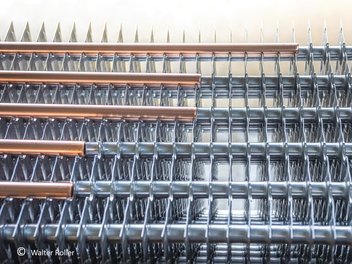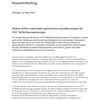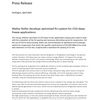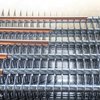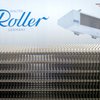Walter Roller develops optimised fin system for CO2 deep-freeze applications
The energy-efficient operation of CO2 deep-freeze applications always goes hand in hand with the evaluation of the fin spacing and necessary defrosting cycles for evaporators. For the use of CO2 in deep-freezing, Roller has now developed an optimised heat exchanger system for evaporators that meets the specific requirements of CO2 (PS 80bar!) for small tube diameters of 9.52 mm, coupled with a maximum fin spacing of 12 mm.
CO2 has become the most important natural refrigerant in refrigeration technology in the grocery market. However, CO2 alone does not make a system energy efficient. To support the energy-efficient characteristics of CO2 in the system technology, Roller has now developed a fin system for evaporators that optimises the energy-intensive defrosting costs in deep-freezing.
The fin spacing of an evaporator has a significant influence on the resulting heat exchanger surface: a closer fin spacing means that more heat can be transferred.
If the fin spacing is too narrow, there is a risk of heavy, disruptive icing, which results in frequent defrosting processes and thus reduces efficiency. Generally, 6-8 mm fin spacing is used in deep-freezing. Even this spacing can be too narrow if the deep-freeze room is affected by increased humidity. Frequent defrosting intervals are the result.
For defrosting, both the direct and indirect costs must be included in the energy cost calculation. The direct costs refer to the electrical defrosting of the ice from the evaporator, the indirect costs to the defrosting heat generated in the room, which must be reabsorbed by the refrigeration system when it restarts.
Reduced defrosting intervals coupled with shorter defrosting cycles and thus lower energy consumption make a positive contribution to energy-efficient system operation.
The high-performance, in-line tube system developed by Roller, with the optimum tube diameter of 9.52 mm (3/8") for CO2 applications, is available with up to 12 mm fin spacing and thus contributes significantly to the requirements of a modern, operationally reliable and efficient deep-freeze system.
Another advantage is the use of 0.3 mm thick aluminium strips for the fin package, which partially compensates for the slight loss of performance of evaporators with a high heat transfer density compared to evaporators with a smaller surface area (due to smaller fin spacing or staggered tube systems). The robust fin thickness also offers the advantage of a high mechanical load capacity, necessary for cleaning work.
The 12mm fin system is already available in Roller's DLK and FHV evaporator series and will be extended to other series in the coming months.
With this development, Roller is following its corporate goal of offering all customers the optimum and most efficient heat exchanger with regard to the refrigerant/fluid used.

